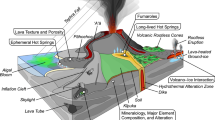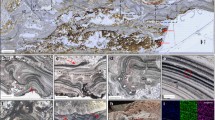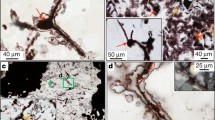Abstract
The ongoing discovery of traces of microbial communities in locations on Earth where conditions are, or were, hostile to life suggests that unknown microbial ecosystems and habitats are yet to be detected. Volcanic environments on the ocean floor provide an important potential habitat for microbial life. Evidence of microbial activity and traces within the primary glassy rinds of basalts have revealed a highly complex microhabitat. Recent findings demonstrate that microbial activity and biodiversity in sub-seafloor volcanic rocks are also more differentiated than previously recognized. In addition to the glassy rinds of subsea pillow basalts, microbial ecosystems that have the potential to preserve traces of life in the geological record have been recognized in vesicular basalts. Here, we present a brief review of the evidence for endolithic microorganisms in volcanic basaltic rocks with an emphasis on the relatively poorly studied vesicular basalts that host microbial ecosystems. These types of habitats are of particular interest in the search for life on rocky, water-bearing terrestrial planets.
Access this chapter
Tax calculation will be finalised at checkout
Purchases are for personal use only
Similar content being viewed by others
6. References
Allen CC, Oehler DZ (2008) A case for ancient springs in Arabia Terra, Mars. Astrobiology 8:1093–1112
Alt JC (1995) Subseafloor processes in mid-ocean ridge hydrothermal systems. In: Humphris SE, Zierenberg RA, Mullineaux LS, Thomson RE (eds) Seafloor hydrothermal systems: physical, chemical, biological, and geological interactions, Geophysical monograph series, 91, pp 85–114
Amend JP, Teske A (2005) Expanding frontiers in deep subsurface microbiology. Palaeogeogr Palaeoclimatol Palaeoecol 219:131–155
Baker VR (2001) Water and the martian landscape. Nature 412:228–236
Banerjee NR, Furnes H, Muehlenbachs K, Staudigel H, de Wit M (2006) Preservation of 3.4–3.5 Ga microbial biomarkers in pillow lavas and hyaloclastites from the Barberton Greenstone Belt, South Africa. Earth Planet Sci Lett 241:707–722
Bedard DL, Bailey JJ, Reiss BL, Van Slyke Jerzak G (2006) Development and characterization of stable sediment free anaerobic bacterial enrichment cultures that dechlorinate Aroclor 1260. Appl Environ Microbiol 72:2460–2470
Beveridge TJ (1989) Role of cellular design in bacterial metal accumulation and mineralization. Annu Rev Microbiol 43:147–171
Bideau D, Hékinian R (1984) Segregation vesicles of ocean floor basalts 1. Petrological study of the segregation products. J Geophys Res 89:7903–7914
Carlut J, Horen H, Janots D (2007) Impact of micro-organisms activity on the natural remanent magnetization of the young oceanic crust. Earth Planet Sci Lett 253:497–506
Carr MH, Head JW III (2010) Geologic history of Mars. Earth Planet Sci Lett 294:185–203
Cavalazzi B, Westall F, Barbieri R (2008) (Crypto-)endoliths from vesicular pillow lavas, Coral Patch Seamount North Atlantic Ocean. Studi Trent Sci Nat Acta Geol 83:177–182
Cavalazzi B, Westall F, Cady SL, Barbieri R, Foucher F (2011) Potential fossil endoliths in vesicular pillow basalt, Coral Patch Seamount, Eastern North Atlantic Ocean. Astrobiology 11:619–632
Cockell CS, Raven JA (2004) Zones of photosynthetic potential on Mars and the early Earth. Icarus 169:300–310
Cockell CS, Cady SL, McLoughlin N (2011a) Introduction: volcanism and astrobiology: life on Earth and beyond. Astrobiology 11:583–584
Cockell CS, Kelly LC, Summers S, Marteinsson V (2011b) Following the kinetics: iron-oxidizing microbial matsin cold icelandic volcanic habitats and their rock-associated carbonaceous signature. Astrobiology 11:679–694
Connell L, Barrett A, Templeton A, Staudigel H (2009) Fungal diversity associated with an active deep sea volcano: Vailulu‘u Seamount, Samoa. Geomicrobiol J 26:8597–8605
Cousins CR, Crawford IA (2011) Volcano-ice interaction as a microbial habitat on Earth and Mars. Astrobiology 11:695–710
D’Hondt S, Rutherford S, Spivack A (2002) Metabolic activity of subsurface life in deep-sea sediments. Science 295:2067–2070
Dartnell LR (2011) Ionizing radiation and life. Astrobiology 11:551–582
Edwards KJ, Bach W, McCollum TM, Rogers DR (2004) Neutrophilic iron-oxidizing bacteria in the ocean: their habitats, diversity, and roles in mineral deposition, rock alteration, and biomass production in the deep-sea. Geomicrobiol J 21:393–404
Edwards KJ, Bach W, McCollom T (2005) Geomicrobiology in oceanography: microbe-mineral interactions at and below the seafloor. Trends Microbiol 13:449–456
Eickmann B, Bach W, Kiel S, Reitner J, Peckmann J (2009) Evidence for cryptoendolithic life in Devonian pillow basalts of Variscan orogens, Germany. Palaeogeogr Palaeoclimatol Palaeoecol 283:120–125
Farmer JD, Des Marais DJ (1999) Exploring for a record of ancient martian life. J Geophys Res 104:26977–26995
Fisk MR, Giovannoni SJ, Thorseth IN (1998) Alteration of oceanic volcanic glass: textural evidence of microbial activity. Science 281:978–980
Fisk MR, Popa R, Mason OU, Storrie-Lombardi MC, Vicenzi EP (2006) Iron-magnesium silicate bioweathering on Earth (and Mars?). Astrobiology 6:48–68
Friedmann EI, Koriem AM (1989) Life on Mars: how it disappeared (if it was ever there). Adv Space Res 9:167–172
Friedmann EI, Ocampo-Friedmann R (1984) Endolithic microorganisms in extreme dry environments: analysis of a lithobiontic microbial habitat. In: Klug MJ, Reddy CA (eds) Current perspectives in microbial ecology. The American Society for Microbiology, Washington, DC, pp 177–185
Furnes H, Staudigel H (1999) Biological mediation in ocean crust alteration: how deep is the deep biosphere? Earth Planet Sci Lett 166:97–103
Furnes H, Banerjee NR, Muehlenbachs K, Staudigel H, de Wit M (2004) Early life recorded in Archean pillow lavas. Science 304:578–581
Furnes H, Banerjee NR, Staudigel H, Muehlenbachs K, McLoughlin N, de Wit M, Van Kranendonk MJ (2007) Comparing petrographic signatures of bioalteration in recent to Mesoarchean pillow lavas: tracing subsurface life in oceanic igneous rocks. Precambrian Res 158:156–176
Glamoclija M, Steele A, Fries M, Schieber J, Voytek MA, Cockell CS (2009) Association of anatase (TiO2) and microbes: unusual fossilization effect or a potential biosignature? Geol Soc Am Spec Pap 458:965–975
Golubic S, Friedmann EI, Schneider J (1981) The lithobiontic ecological niche, with special reference to microorganisms. J Sediment Petrol 51:475–478
Golubic S, Radtke G, Le Campion-Alsumard T (2005) Endolithic fungi in marine ecosystems. Trends Microbiol 13:229–235
Grotzinger J, Beaty D, Dromart G, Gupta S, Harris M, Hurowitz J, Kocurek G, McLennan S, Milliken R, Ori GG, Sumner D (2011) Mars sedimentary geology: key concepts and outstanding questions. Astrobiology 11:77–87
Heim C (2011) Terrestrial deep biosphere. In: Reitner J, Thiel V (eds) Encyclopedia of geobiology. Springer, Dordrecht, pp 871–876
Hofmann BA, Farmer JD, Von Blanckenburg F, Fallick AE (2008) Subsurface filamentous fabrics: an evaluation of possible modes of origins based on morphological and geochemical criteria, with implications for exoplaeontology. Astrobiology 8:87–117
Honnorez J (1978) Generation of phillipsites by palagonitization of basaltic glass in sea water and the origin of K-rich deep-sea sediments. In: Sand LB, Mumpton FA (eds) Natural zeolites, occurrence, properties, use. Pergamon Press, Oxford, pp 45–258
Honnorez J (1981) The aging of the oceanic crust at low temperature. In: Emiliani E (ed) The sea, vol 7. Wiley, New York, pp 525–587
Ivarsson M, Lindblom S, Broman C, Holm NG (2008a) Fossilized microorganisms associated with zeolite–carbonate interfaces in sub-seafloor hydrothermal environments. Geobiology 6:155–170
Ivarsson M, Lausmaa J, Lindblom S, Broman C, Holm NG (2008b) Fossilized microorganisms from the Emperor Seamounts: implications for the search for a subsurface fossil record on Earth and Mars. Astrobiology 8:1139–1157
Jakosky B, Westall F, Brack A (2007) Mars. In: Sullivan W, Baross J (eds) Planets and life. The emerging science of astrobiology. Cambridge University Press, Cambridge, pp 357–387
Jones JG (1969) Pillow lavas as depth indicators. Am J Sci 267:181–195
Jorge Villar SE, Edwards HGM, Benning LG (2006) Raman spectroscopic and scanning electron microscopic analysis of a novel biological colonisation of volcanic rocks. Icarus 184:158–169
Kashefi K, Lovley DR (2003) Extending the upper temperature limit for life. Science 301:934
Konhauser KO (1998) Diversity of bacterial iron mineralization. Earth Sci Rev 43:91–121
Konhauser KO, Ferris FG (1996) Diversity of iron and silica precipitation by microbial mats in hydrothermal waters, Iceland: implications for Precambrian iron formations. Geology 24:323–326
Konhauser KO, Urrutia MM (1999) Bacterial clay authigenesis: a common biogeochemical process. Chem Geol 161:399–413
Lewis KW, Aharonson O, Grotzinger JP, Squyres SW, Bell JF III, Crumpler LS, Schmidt ME (2008) Structure and stratigraphy of Home Plate from the Spirit Mars Exploration Rover. J Geophys Res (Planets) 113:E12S36
Lippmann-Pipke J, Sherwood Lollar B, Niedermann S, Stroncik NA, Naumann R, van Heerden E, Onstott TC (2011) Neon identifies two billion year old fluid component in Kaapvaal Craton. Chem Geol 283:287–296
Mason OU, Stingl U, Wilhelm LJ, Moeseneder MM, Di Meo-Savoie CA, Fisk MR, Giovannoni SJ (2007) The phylogeny of endolithic microbes associated with marine basalts. Environ Microbiol 9:2539–2550
Mason OU, Di Meo-Savoie CA, Van Nostrand JD, Zhou JZ, Fisk MR, Giovannoni SJ (2009) Prokaryotic diversity, distribution, and insights into their role in biogeochemical cycling in marine basalts. ISME J 3:231–242
McLoughlin N, Brasier MD, Wacey D, Green OR, Randall SP (2007) On biogenicity criteria for endolithic microborings on early Earth and beyond. Astrobiology 7:10–26
McLoughlin N, Furnes H, Banerjee NR, Muehlenbachs K, Staudigel H (2009) Ichnotaxonomy of microbial trace fossils in volcanic glass. J Geol Soc Lond 166:159–169
Monty CLV, Westall F, Van Der Gaast S (1991) The diagenesis of siliceous particles in subantartcic sediments, ODP Leg 114, Hole 699: possible microbial mediation. In: Ciesielski PF, Kristoffersen Y et al (eds) Proceedings of the ocean drilling program science results, 114. Ocean Drilling Program, College Station, pp 685–710
Moore JG (1970) Water content of basalt erupted on the ocean floor. Contrib Mineral Petrol 28:272–279
Nielsen ME, Fisk MR (2010) Surface area measurements of marine basalts: implications for the subseafloor microbial biomass. Geophys Res Lett 37:L15604
Nisbet EG, Sleep NH (2001) The habitat and nature of early life. Nature 409:1083–1091
Nisbet E, Zahnle K, Gerasimov A, Jaumann R, Hoffman B, Helbert H, Benzerara K, Westall F, Gilmour I (2007) Creating habitable zones, at all scales, from planets to muds, on Earth and on Mars. Geology and habitability of terrestrial planets. Space Sci Rev 129:79–121
Onstott TC, Tobin K, Dong H, DeFlaun MF, Fredrickson JK, Bailey T, Brockman F, Kieft T, Peacock A, White DC, Balkwill D (1997) The deep gold mines of South Africa: window into the subsurface biosphere. Proc SPIE 3111:344–357
Parkes RJ, Webster G, Cragg BA, Weightman AJ, Newberry CJ, Ferdelman TG, Kallmeyer JB, Jørgensen B, Aiello IW, Fry JC (2005) Deep sub-seafloor prokaryotes stimulated at interfaces over geological time. Nature 436:390–394
Parsons B (1981) Rates of plate creation and consumption. Geophys J R Astron Soc 67:437–448
Peck DL (1978) Cooling and vesiculation of Alae Lava Lake, Hawaii. U.S. Geological Survey Professional Paper, 935-B. U.S. Geological Survey, Washington, DC
Peckmann J, Bach W, Behrens K, Reitner J (2008) Putative cryptoendolithic life in Devonian pillow basalt, Rheinisches Schiefergebirge, Germany. Geobiology 6:125–135
Pedersen K (2000) Exploration of deep intraterrestrial life: current perspectives. FEMS Microbiol Lett 185:9–16
Pondrelli M, Rossi AP, Marinangeli L, Hauber E, Gwinner K, Baliva A, Di Lorenzo S (2008) Evolution and depositional environments of the Eberswalde fan delta, Mars. Icarus 197:429–451
Preston LJ, Izaza MRM, Banerjee NR (2011) Infrared spectroscopy characterization of organic matter associated with microbial bioalteration textures in basaltic glass. Astrobiology 11:585–599
Rogers JR, Bennett PC (2004) Mineral simulation substance microorganisms: release of limiting nutrients from silicates. Chem Geol 203:91–108
Rothschild LJ, Mancinelli RL (2001) Life in extreme environments. Nature 409:1092–1101
Santelli CM, Orcutt BN, Banning E, Bach W, Moyer CL, Sogin ML, Staudigel H, Edwards KJ (2008) Abundance and diversity of microbial life in ocean crust. Nature 453:653–656
Schmidt ME, Ruff SW, McCoy TJ, Farrand WH, Johnson JR, Gellert R, Ming DW, Morris RV, Cabrol N, Lewis KW, Schroeder C (2008) Hydrothermal origin of halogens at Home Plate, Gusev Crater. J Geophys Res (Planets) 113:E06S12
Schumann G, Manz W, Reitner J, Lustrino M (2004) Ancient fungal life in North Pacific Eocene oceanic crust. Geomicrobiol J 21:241–246
Shabtai Y, Fleminger G (1994) Adsorption of Rhodococcus strain GIN-1 (NCIMB 40340) on titanium dioxide and coal fly ash particles. Appl Environ Microbiol 60:3079–3088
Skok JR, Mustard JF, Ehlmann BL, Milliken RE, Murchie SL (2010) Silica deposits in the Nili Patera caldera on the Syrtis Major volcanic complex on Mars. Nat Geosci 3:838–841
Smith RE (1967) Segregation vesicles in basaltic lava. Am J Sci 265:696–713
Southam GL, Rothschild L, Westall F (2007) The geology and habitability of terrestrial planets: fundamental requirements for life. Space Sci Rev 129:7–34
Squyres SW, Arvidson RE, Ruff S, Gellert R, Morris RV, Ming DW, Crumpler L, Farmer JD, Des Marais DJ, Yen A, McLennan SM, Calvin W, Bell JF III, Clark BC, Wang A, McCoy TJ, Schmidt ME, de Souza PA Jr (2008) Detection of silica-rich deposits on Mars. Science 320:1063–1067
Stan-Lotter H, Fendrihan S (2011) Deep biosphere of salt deposits. In: Reitner J, Thiel V (eds) Encyclopedia of geobiology. Springer, Dordrecht, pp 313–317
Staudigel H, Furnes H, McLoughlin N, Banerjee NR (2008) 3.5 billion years of glass bioalteration: volcanic rocks as basis for microbial life? Earth Sci Rev 89:156–176
Storrie-Lombardi MC, Fisk MR (2004) Elemental abundance distributions in sub-oceanic basalt glass: evidence of biogenic alteration. Geochem Geophys Geosyst 5. doi:10.1029/2004GC000755
Stroncik NA, Schmincke H-U (2001) Evolution of palagonite: crystallization, chemical changes, and elemental budget. Geochem Geophys Geosyst 2. doi:10.1029/2000GC000102
Takai K, Moser DP, DeFlaun MF, Onstott TC, Fredrickson JK (2001) Archaeal diversity in waters from deep South African gold mines. Appl Environ Microbiol 67:5750–5760
Thorseth IH (2011) Basalt (glass, endoliths). In: Reitner J, Thiel V (eds) Encyclopedia of geobiology. Springer, Dordrecht, pp 103–111
Thorseth IH, Furnes H, Heldal M (1992) The importance of microbiological activity in the alteration of natural basaltic glass. Geochim Cosmochim Acta 56:845–850
Thorseth IH, Furnes H, Tumyr O (1995) Textural and chemical effects of bacterial activity on basaltic glass: an experimental approach. Chem Geol 119:139–160
Thorseth IH, Pedersen RB, Christie DM (2003) Microbial alteration of 0-30-Ma seafloor and sub-seafloor basaltic glasses from the Australian Antarctic discordance. Earth Planet Sci Lett 215:237–247
Torsvik T, Furnes H, Muehlenbachs K, Thorseth IH, Tumyr O (1998) Evidence for microbial activity at the glass-alteration interface in oceanic basalts. Earth Planet Sci Lett 162:165–176
Verrecchia EP (2000) Fungi and sediments. In: Riding R, Awramik SM (eds) Microbial sediments. Springer, New York, pp 68–75
Warner NH, Farmer JD (2010) Subglacial hydrothermal alteration minerals in jökulhlaup deposits of southern Iceland, with implications for detecting past or present habitable environments on Mars. Astrobiology 10:523–547
Westall F, Cavalazzi B (2011) Biosignatures in rocks. In: Reitner J, Thiel V (eds) Encyclopedia of geobiology. Springer, Dordrecht, pp 189–201
Whitman WB, Coleman DC, Wiebe WJ (1998) Prokaryotes: the unseen majority. Proc Natl Acad Sci U S A 95:6578–6583
Wierzchos J, Ascaso C, McKay CP (2006) Endolithic cyanobacteria in halite rocks from the hyperarid core of the Atacama Desert. Astrobiology 6:415–422
Wilson L, Head JW (1994) Mars: review and analysis of volcanic eruption theory and relationships to observed landforms. Rev Geophys 32:221–263
Wynn-Williams DD, Edwards HGM (2000) Antarctic ecosystems as models for extraterrestrial surface habitats. Planet Space Sci 48:1065–1075
5. Acknowledgements
We gratefully thank Le Studium, Institute for Advanced Studies, Region Centre, Orléans, France, and the NASA Exobiology Program and NASA Astrobiology Institute. Thanks are due to Nisha Mathew, University of the Witwatersrand, who kindly reviewed the English version of the chapter. BC would like to thanks Paula F. Martínez, Johannesburg.
Author information
Authors and Affiliations
Corresponding author
Editor information
Editors and Affiliations
Rights and permissions
Copyright information
© 2012 Springer Science+Business Media Dordrecht
About this chapter
Cite this chapter
Cavalazzi, B., Westall, F., Cady, S.L. (2012). Vesicular Basalts as a Niche for Microbial Life. In: Hanslmeier, A., Kempe, S., Seckbach, J. (eds) Life on Earth and other Planetary Bodies. Cellular Origin, Life in Extreme Habitats and Astrobiology, vol 24. Springer, Dordrecht. https://doi.org/10.1007/978-94-007-4966-5_4
Download citation
DOI: https://doi.org/10.1007/978-94-007-4966-5_4
Published:
Publisher Name: Springer, Dordrecht
Print ISBN: 978-94-007-4965-8
Online ISBN: 978-94-007-4966-5
eBook Packages: Biomedical and Life SciencesBiomedical and Life Sciences (R0)




